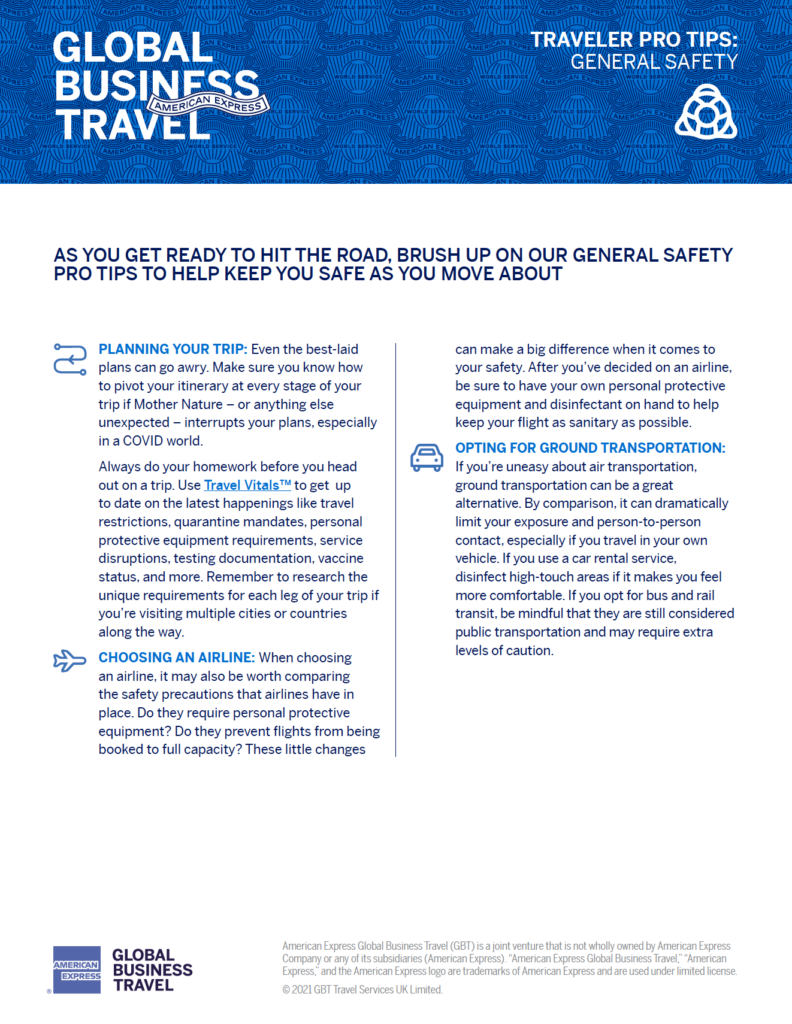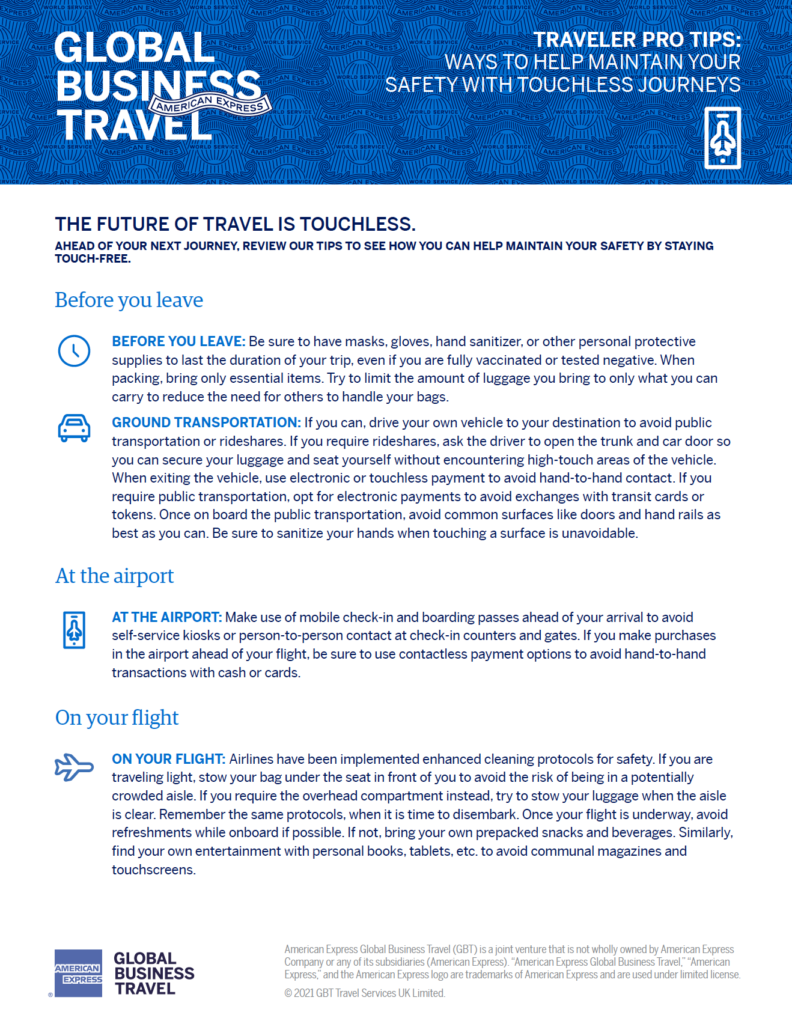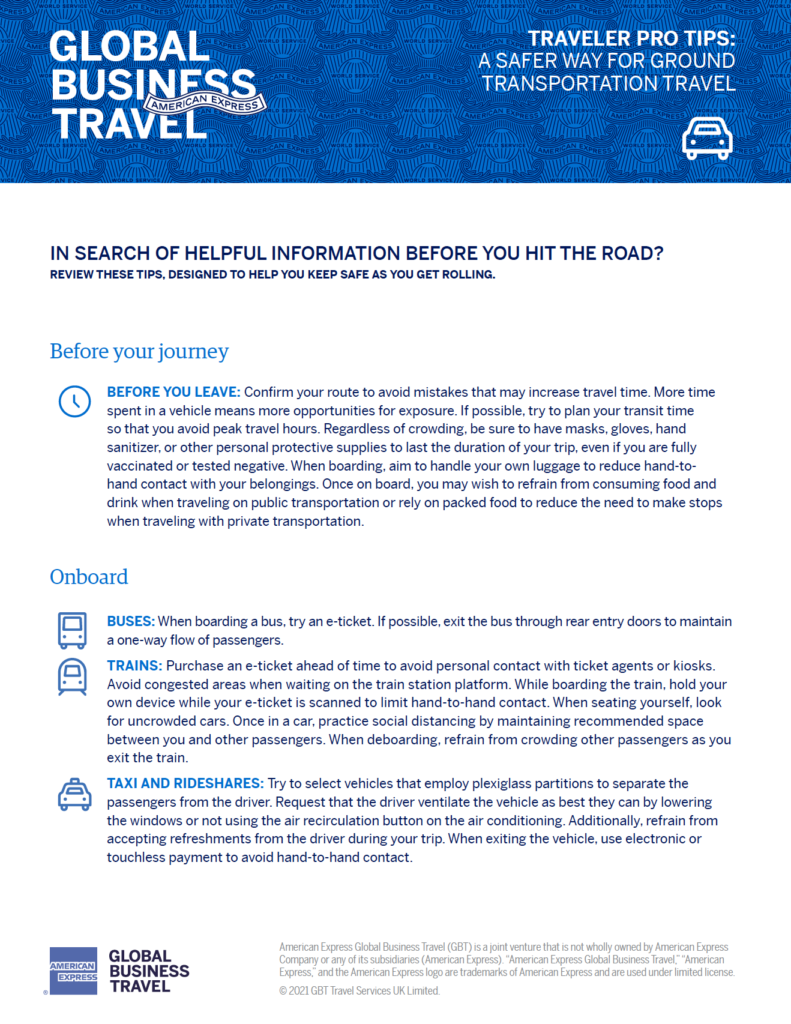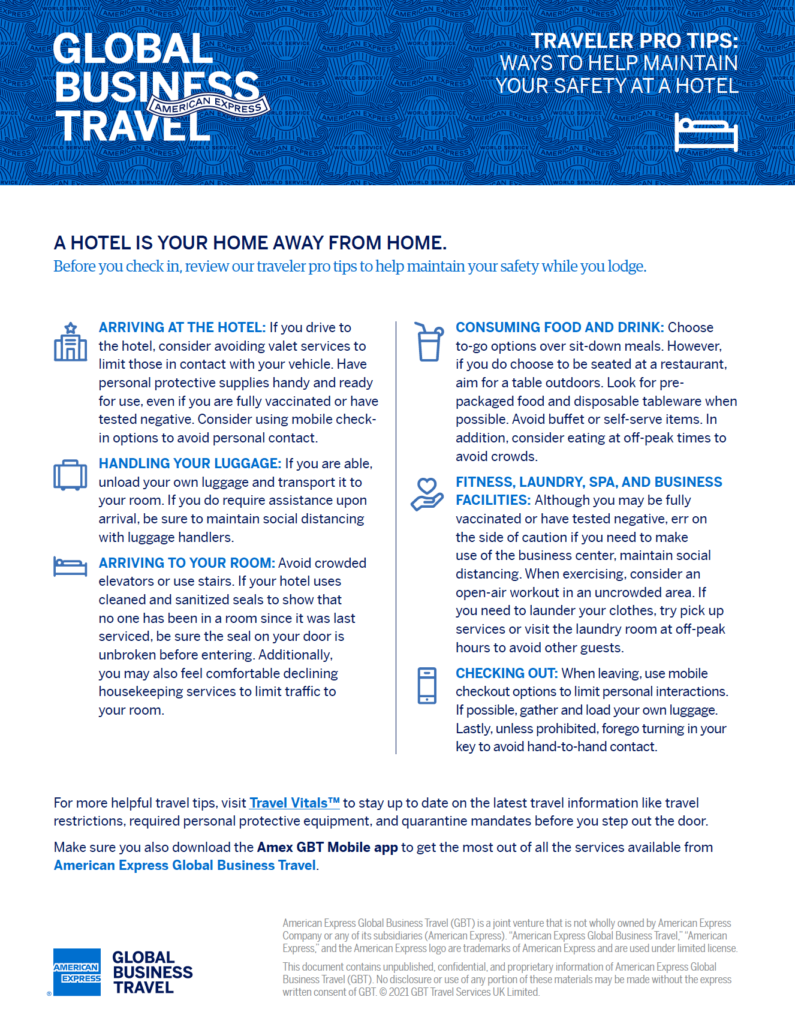As travel has begun to rise with the rollout of vaccines, we’ve been receiving more queries from clients about how to restart their travel programs. Our response: It depends on how soon you plan to relaunch. Later this year, later this quarter, or later this month?
To help companies think through the steps of each phase of the relaunch, we’ve created this stage-by-stage guide.
If you’re 6+ months out from traveling
You can begin by building a project plan for welcoming the return to travel and in-person meetings at your organization. This process will entail mapping out key milestones connected to duty of care, suppliers, budget, traveler safety, well-being, etc.
Next, define the stakeholders who will be involved. The choice may be obvious if you already have built relationships and committees with representatives from the HR, legal, security, finance, and executive leadership teams that have weighed in on travel program decisions during the pandemic. Continue relying on these partnerships to navigate the new realities ahead, including health passports and travel restrictions. Your travel management company (TMC) also can help you to manage these complexities.
Something else that can be added to the agenda: building a better travel program that aligns with your company values. The relaunch poses the perfect opportunity to weave in and introduce sustainability targets and inclusivity initiatives.
If you haven’t already, start gauging how employees feel about traveling again. You could chat directly with the company’s top travelers to understand their desire to return to travel and concerns as well as enlist HR’s help to conduct surveys that capture the sentiments of a larger base of employees who take business trips.
Now’s also the time to develop a communication strategy and training plans to ease into the transition. You’ll want to draft messages that demonstrate the efforts made to keep employees safe, any new policies they’ll need to follow (e.g., a pre-trip approval process), the tools and resources available to them, and where they can seek help if they have a travel-related query or issue. Finding ways to step up communications before, during, and after a trip can also help employees feel supported as they travel again.
If you’re 3+ months out from traveling
From employee surveys, you may discover that some travelers are eager to get back on the road, while others are still hesitant. Use this feedback to create traveler risk profiles to identify how the return to travel and meetings may impact different employees and devise strategies to alleviate the concerns of those struggling with the idea.
While you may have already created a COVID-19 travel policy to guide employees on new processes and protocols, take a second look to make sure you’ve taken into account any recent developments that could impact your program, including new supplier changes and government regulations. You can use our Travel Vitals™ site to compile a lot of this intel.
Some essential guidelines to cover in a COVID-19 travel policy: what constitutes “permissible” travel; who will be able to travel (i.e., perhaps only those who have been vaccinated?), safety initiatives that have been implemented, and any new guidelines that have been adopted to support traveler wellness, sustainability, and inclusivity goals.
Also spell out the process for a pre-trip approval system that may have been set up since the pandemic, including the criteria that will be used to evaluate trip requests.
Before creating a final draft of the policy, you may want to run changes by your frequent travelers and team leaders to see if they have any suggested revisions.
Because of all the changes happening within the industry, you should connect with your preferred suppliers at this point to understand how ready they are to receive your travelers. Hotels may have come under new management or closed permanently and airlines may have altered some routes that impact your company’s top destinations. If there are gaps, work with your procurement team to find other solutions and be sure to convey these changes to travelers.
If you’re one month out from traveling
During this month, the focus will be on testing all the program elements to facilitate a smooth transition. New tools and systems that have been put in place should be checked to make sure they are operating well to avoid chaos and confusion when the switch is flipped.
Make sure the online booking tool is working properly. You may simulate bookings to confirm the correct content is being displayed and that any push notifications you have included in the tool are popping up on the right screens. Test out the pre-trip approval tool to verify that reviewers are receiving requests and able to take action.
So your partners are fully prepared as well, notify your TMC and other suppliers about your plans to relaunch the program and any program changes they should be aware of. This way, they can conduct capacity planning and be fully ready to welcome back your travelers.
At this stage, also notify your employees of the relaunch. HR may send company-wide announcements informing employees about the countdown to the return of travel and in-person meetings, with subsequent emails focusing on critical policy changes and the resources available to travelers.
After these announcements go out, there may be a flood of emails with questions and concerns from those who potentially will be traveling again, so you may want to form ahead of time a committee who can field these queries and let employees know where they can turn for help. The committee might be comprised of representatives from HR and the travel department as well as frequent travelers who can serve as ambassadors to their peers. Training guides and travel-related resources that can aid with the transition should also be prepared and finalized at this stage.
You can share these Traveler Pro Tip guides we’ve put together – a collection of our best advice on how employees can safely resume business trips.
You are ready to travel
It’s ready for program takeoff. As travelers are given the green light to begin taking their first work trips since the pandemic, communication and training are key.
First, send a company-wide announcement via email, intranet, and/or townhall, indicating the reinstatement of travel. Detail the resources that are available to travelers and provide training on policy changes, offering guidance on what types of trips they can take and any new protocols on booking processes. Follow up with additional emails and an internal blog summarizing key points.
With all the changes that have taken place in the industry, the return to travel may not be the smoothest ride, and travelers will need all the support they can get. We recommend organizing a dedicated team who can assist travelers with the questions and challenges that inevitably will arise.
Frequent travelers who’ve taken business trips since the pandemic also may be of assistance, sharing their experiences and tips in a video or internal blog.
Your TMC can serve as a support system as well, guiding travelers on booking decisions and making them aware of destination-specific travel advisories and requirements. By the way, this is a good time to supply travelers with the contact information and chat assistance for the TMC’s traveler care team they can use when they need help with bookings or on the road.
Your TMC may have many other resources you can share with your employees to help them navigate the return to travel. In fact, we’ve built an entire #TravelReady site where travelers can access the latest travel updates, guides, and tips to confidently make plans and preparations. Be sure to check it out – the site is a valuable resource for travel managers and travel arrangers too!
We also are hosting a “Getting TravelReady” webinar to help companies that are still grounded relaunch their travel programs. It is being led by Matt Burnett, a senior consultant with our Global Business Consulting team, and Paul McDonnough, manager of account development.
Getting ready for your next business trip? To help you prepare for safe travels, we’ve put together a checklist that outlines the considerations travelers should take into account as they map out and plan their next journey. It includes everything from which questions to ask when choosing an airline carrier to what features to look for in a hotel as well as tips when opting to travel by ground.
Click the image below to view the checklist and learn what you can do to maximize your safety and well-being at every step of your next trip.
Technology has made it easier for travelers to limit the surfaces they touch in public during a trip.
In this tip sheet we have put together, we explore the ways you can conduct various segments of a business trip with little physical interaction – and how to keep safe when contact is inevitable.
Click the image below to learn business travel safety tips, the ways you can go touch-free during your next journey.
Getting ready to roll on your next journey and looking for business travel safety tips? To help keep you safe the next time you hit the road, we’ve compiled a list of tips designed to protect your health and well-being as you maneuver from Point A to Point B. Whether you are taking a personal car, rental, rideshare, bus, or train, we’ve got you covered.
Click the image below to see how you can keep safe while you’re on the go on the ground.
Many hotel brands have introduced enhanced safety and cleaning protocols over the last few months, but guests should also take extra precautions to maintain their well-being during an overnight stay.
To help you prepare for your next hotel stay, we’ve compiled a checklist designed to keep you safe throughout the entire duration of your visit, from check-in to checkout.
Click the image below to view the checklist and discover what you can do to maintain your safety while lodging at your home away from home.
Duty of care is a top priority for travel programs right now. Companies worldwide are implementing new security and health standards to keep traveling employees safe.
To help you identify any gaps in your duty of care program, we have developed this editable self-assessment scorecard so you can evaluate your program and create goals to address any weaknesses.
The travel restart brings opportunities to overhaul your travel program, from reshaping supplier relationships to reducing the environmental impacts of business travel. The Global Business Consulting (GBC) team at American Express Global Business Travel (GBT) works with clients to help them optimize their travel programs. Here, GBC consultants identify key trends as travel begins to return and explore what they mean for travel managers.
Air: Health Passports and Your Program
Sourcing Hotel Program in 2021
Optimizing Your Modern Program – Green
Optimizing Your Modern Program – Wellbeing
Optimizing Your Modern Program – Communication/Engagement
Optimizing Your Modern Program – Policy
AIR: HEALTH PASSPORTS AND YOUR PROGRAM
Health passports will aid the return of travel but could create complications if not done right.
Jeremy Quek, principal global air practice line lead
Health passports, pivotal to restarting cross-border travel, will benefit from consistent technology and government standards.
In 2020, air corridors (aka “air bubbles”) were seen as necessary for removing the threat of quarantines and reopening international borders, particularly among traditional trade partners or where historical-cultural relationships exist. But as governments and airlines increasingly require proofs of negative COVID-19 tests or vaccination before allowing travelers to past border control, digital health passports are emerging as the key to get the world moving again.
There are at least a couple of dozen digital health wallets already in existence, and additional platforms emerge almost every week. GBT has been talking to the three main players – the International Air Transport Association’s Travel Pass, VeriFLY, and CommonPass – to communicate the needs of business travelers in terms of reliability, security, and portability across multiple carriers and jurisdictions.
With different health passport systems in operation, there needs to be consistent interoperable technology standards if there’s going to be seamless movement of people within the travel ecosystem. This means the way traveler data is stored, used, transferred, and processed in a secure manner respecting privacy rules needs to be agreed on by governments.
Since these health wallets are still in the infancy stage, it’s early for corporates to select a single app that will fulfill the requirements of all jurisdictions where they do business, and clients are playing “wait and see” before committing to any one health wallet standard. In the meantime, tools like GBT’s Travel Vitals™ can help keep travelers and travel managers on top of the latest requirements and understand if a health passport – and from which provider – will be necessary to board a flight.
SOURCING HOTEL PROGRAM IN 2021
Take the long-term view when sourcing hotels
Nina Marcello, principal, global hotel practice lead
Sourcing hotels has become a very different game: what are the new rules?
Hotels have been under immense pressure, operating at vastly reduced capacity with the lowest occupancy rates on record. They have had to meet additional costs around cleaning protocols, particularly when rooms must be left vacant between guests. Revenue per available room has gone down, so hotels have had to find other ways to maintain revenues, such as offering meeting space to corporations as an extension of their office space.
Buyers might see this as the ideal moment to overhaul their sourcing strategy, but this only makes sense if they have sufficient volume in their program. Many hotels just don’t have the staff to work on RFPs and many won’t take corporations seriously if they plan to book only 40 nights per month.
To make sure they can get the rooms they need, at the right rates, buyers need to take a longer-term view. Sourcing in today’s fluid environment is a continuous process: don’t just roll over your rates or fix and forget. Keep an eye open as volumes return, maintain relationships, and talk regularly with top partners so they understand what kind of support you need when travel starts moving again. And, as part of their focus on rates management, buyers need to make sure they get any available percentage discounts off the best available rate when this is lower than their negotiated rates and take advantage of resources like travel management company (TMC) rates and re-shopping tools.
Technology continues to transform ground transportation
Sesilia Kalss, Germany team lead
Susan Austin, principal
Technology enables ground providers to offer more personalized and sustainable travel options.
Cars are often synonymous with ground. During the pandemic, rental volumes have declined – but to a much smaller extent than air: corporates and travelers view cars as a relatively safe transportation option that limits exposure and offers greater privacy versus other modes. The increasing prevalence of app-based, touchless experiences provides even more reassurance. To accommodate the growth in remote working, rental providers in North America have been opening rental locations in suburbs, conveniently sited for home workers.
Sustainability is a key theme in ground, particularly in Europe. Corporates less impacted by the pandemic, for example, chemicals or pharmaceuticals companies, continue to advance green initiatives, such as introducing hybrid or electric vehicles to their fleets. At least one GBT client aims to achieve carbon neutrality by 2025. But many corporates have postponed plans to shift to greener, often more expensive, fleet options.
Moves to reduce carbon emissions are bringing a growing focus on rail. Pre-COVID, the train could be five times more expensive than the plane. As airlines reduce the number of flights and fares could rise as demand returns, rail is becoming more competitive on cost. Rail is also increasingly visible: modern online booking tools make it easy for travelers to directly compare the emissions impact of different modes.
Corporate travel mobility-as-a-service (MaaS) platforms will start to go mainstream over the coming months. Integrating ground transportation options into a single, user-friendly platform, MaaS offers travelers convenience and simplicity. For corporates, it means less leakage, supports traveler safety, and simplifies travel and expense management. Some GBT clients are building proprietary MaaS platforms, while others adopt white-label options like Mozio. Whatever the approach, the first step requires organizations to centralize responsibility for ground procurement in a single department, which can steer the integration process.
OPTIMIZING YOUR MODERN PROGRAM: GREEN
Travel should take the lead on sustainability
Edward Hunt, consultant
A decade ago, the financial crisis knocked sustainability off the corporate agenda. In contrast, the pandemic has seen many GBT clients intensify their focus on sustainability.
Sustainability is increasingly recognized as a strategic business issue and a source of long-term value. When travel shut down in early 2020, travel managers prioritized getting their travelers home safely and adjusting policy. Once the dust had settled, progressive GBT clients returned to considering how travel can contribute to their organizations’ sustainability strategy. They understand sustainability cannot be an optional extra: it is integral to managed travel.
Many businesses are taking advantage of the lull in activity to “build back greener” and corporate ESG teams are already applying pressure on travel leaders to do their part. Coincidentally, as travelers take their first tentative steps to once again realizing the Power of Presence, travel managers will have their attention as never before.
Travel managers are exploring how they can take this opportunity. They plan to use enterprise collaboration platforms like Chatter to engage with their travelers on sustainability initiatives. They are already investing in robust, detailed carbon footprint data sets that go beyond basic public-domain measurements, giving their stakeholders confidence in the data. And they’re working with their TMCs to improve point-of-sale tools, making it easier for travelers to understand the environmental impact of different travel options.
All of this represents an unprecedented shift in stakeholder expectations – but for travel managers, it will create an opportunity to demonstrate leadership in their organization.
OPTIMZING YOUR MODERN PROGRAM: WELL-BEING
Supporting traveler well-being as travel returns
Ciska Teunis, senior consultant
Sarah-Jane Tempest, Regional APAC travel program manager lead
Employees may not want to return to their former travel patterns. Travel managers need to be ready to support them.
Before the shutdown, corporates increasingly understood that frequent business travel had significant impacts on employee well-being, some positive and others less so. While they have been working from home, travelers will have had an opportunity to reflect on how travel – and the absence of travel – have affected them.
The emergence of effective vaccines makes the return of business travel a question of “when” not “if,” which means this is the time for travel managers to survey employees to gauge travel sentiment and understand why they need to travel.
Next to that, travel managers will need to consider how they can best support the well-being of their returning frequent travelers. Combining HR data, such as job code or tenure, with travel data gives travel managers a deep understanding of how travel impacts individuals. With this insight, they can identify travelers at risk of burnout and put in place well-chosen improvements in traveler experience, such as improvements in travel comfort or “time-for-time” compensation that recognizes the impact of long-haul night flights. This capability will be critical to protecting employee well-being when business travel returns as the pandemic recedes.
OPTIMIZING YOUR MODERN PROGRAM: COMMUNICATION/ENGAGEMENT
Traveler engagement matters more than ever
Jennifer Pratt, principal consultant
Now’s the time to rebuild and strengthen engagement.
Increasingly, organizations understand how effective traveler engagement can support their program objectives, enabling them to inform and influence travelers and drive compliance. Engagement is a two-way process – as much about listening as it is about broadcasting. But during the pandemic, many organizations – not wanting to encourage travel – effectively stopped communicating with travelers.
There’s never a good time to stop communicating. While travel is curtailed, we encourage organizations to maintain an open dialogue with travelers. So, what do you talk about when you can’t talk about itineraries and destinations? At GBT, colleagues have been sharing stories on our social media channels about their experiences of traveling during the pandemic. Clients are also discovering creative ways to keep the conversation going: One travel team is running a wellness campaign on their social channels. As well as driving engagement, the campaign showcases suppliers for both business and leisure travel and chimes with the client’s wider focus on employee well-being.
Above all, this is the time for organizations to optimize their engagement channels to prepare for the return of travel. As soon as this seems imminent, the volume of traveler inquiries will rocket. It’s been many months since most people have been on the road – in a sense, everyone is a new traveler now. Even former frequent travelers could be feeling nervous about resuming travel.
Travel managers should act now to make sure travelers know where they can find information and be ready to send policy updates via all their channels. As a first step, they should review their primary communication tools like the online booking tool and intranet pages. Which channels do travelers use and find valuable?
OPTIMIZING YOUR MODERN PROGRAM: POLICY
Updating policy for the new travel landscape
Freyja Donkersloot, global program optimization practice line lead
Marcel van Gaal, BENELUX lead
The pandemic brought significant changes to business travel – from supplier relationships to traveler experience, traveler safety, traveler engagement, and sustainability. That means policy must change too.
During the pandemic, policy has played a vital role in traveler safety – primarily, with organizations adding restrictions on traveler behavior. With the return of travel on the horizon, policy will be center stage. Travel managers should be getting ready now to adapt their policy to manage demand and support traveler needs. This can be achieved by improving traveler safety guidelines, providing travel alternatives, and defining business travel criticality.
Re-evaluating and updating the reasons for travel in the policy and online booking tools should be a key focus. Since March 2020, travel has been mainly restricted to “business critical” trips – but many organizations lack a single definition of what “business critical” meant. Agreeing on a single definition with companywide stakeholders and incorporating this in adapted travel reason codes or adjusted policy guidelines will enable organizations to optimize travel spend in a safe and sustainable manner or encourage travel alternatives where feasible. This exercise will also allow imprecise legacy definitions, such as “internal meeting” and “client meeting” to be tidied up.
Approvals is another priority area for attention: this is a critical checkpoint for traveler safety, supporting the use of approved suppliers, and control of when it is justified to travel. Travel managers should review their policy on approvals and restructure the approval process as necessary.
While traveler safety and cost management remain paramount, travel managers should look to expand policy to encompass topics such as sustainability and traveler well-being, which includes both physical health and safety and mental wellness. These topics resonate with travelers – incorporating them in the program will support greater compliance.
To share more about the seven trends shaping the sector this year, we have put together a special webinar featuring two GBC directors – James Ranney and Philip Haxne – that took place on March 18, 2021.
To view the on-demand recording, click here.
To find out how the GBC team can help them optimize their program to deliver more value, visit Global Business Consulting.



